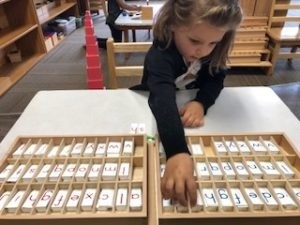 What is the uninterrupted work period? Unlike other schools, the Montessori classroom offers children the chance to explore and engage with a prepared environment for a set block of time. If you’re new to Montessori, take a look at the top questions answered about this cornerstone of classroom practice.
What is the uninterrupted work period? Unlike other schools, the Montessori classroom offers children the chance to explore and engage with a prepared environment for a set block of time. If you’re new to Montessori, take a look at the top questions answered about this cornerstone of classroom practice.
How Long Is the Work Period?
There’s no specific or set time for each work period. The number of minutes or hours children engage in independent exploration depends on:
- Age. The younger the child group, the shorter the work period (also known as work cycle) is. Toddlers may have an hour-long cycle while preschoolers have two or even three hours. Older children often engage in a three-hour work period.
- Work options. As students grow and develop, they can engage in more complex tasks. This requires longer periods of uninterrupted time.
- Other activities. The work cycle is not a time for directed or class lessons — even in the elementary years. The educator will plan work periods separate from outdoor play times, whole group activities, special classes, and meals.
If you want to understand more about the length of time the teacher chooses for your child’s work cycle, just ask. The Montessori educator can explain how these, and other individual classroom factors, influence the chosen period.
Why Is the Work Period Important?
Again, the uninterrupted work cycle doesn’t include group lessons, special activities, or outdoor play. But if the period doesn’t include lessons, why is it an important part of the Montessori day?
The work period allows children to:
- Foster independence. The ability to explore without interruption during a self-study period can build a sense of independence in toddlers, preschoolers, and older children.
- Make choices. Does your child struggle to make decisions or choose activities at home? This work period can help them to overcome whatever holds them back from making choices.
- Engage with classroom materials. The work period gives your child the chance to explore the prepared environment of the Montessori classroom. As your child makes their own choices and discoveries, they have the chance to work with the Montessori materials.
- Learn their own way. Different children learn in different ways. The uninterrupted work period allows children to make their own discoveries and learn in a way that best suits their individual needs.
- Focus and concentrate. The uninterrupted focus of the work period provides children with the chance to focus and concentrate. They can later translate this ability into other areas of their educational or at-home lives.
- Develop new skills. The overriding goal of most educational environments is to help the child grow and develop. Whether the child builds cognitive skills, grows emotionally, or improves physical abilities, the work period helps development on multiple levels.
Like with time periods, you can talk to the teacher if you have any questions. The Montessori educator can clarify how this key part of the day helps your child to grow as a person and develop as a student.
 What Does the Work Period Include?
What Does the Work Period Include?
No general or uniform answer to this question exists. The uninterrupted work cycle is child-directed. This means your child is in charge of what they do, explore, and learn during each period.
Not only do the choices vary by child, but they also differ by age and developmental level. The teacher will provide the students with materials to choose from and explore on their own. In some cases, the teacher may need to step in to model or guide the child — but the educator won’t direct activities or take away the child’s freedom to choose.
Is your child ready to start an adventure in a Montessori classroom? Contact us at Miniapple International Montessori School for more information.

